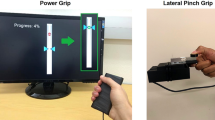Abstract
Alternate grip strategies are often used for object manipulation in individuals with sensorimotor deficits. To determine the effect of grip type on force control, ten healthy adult subjects were asked to grip and lift a small manipulandum using a traditional precision grip (lateral pinch), a pinch grip with the fingers oriented downwards (downward pinch) and a “key grip” between the thumb and the side of the index finger. The sequence of grip type and hand used was varied randomly after every ten lifts. Each of the three grips resulted in different levels of force, with the key grip strategy resulting in the greatest grip force and the downward pinch grip using the least amount of grip force to lift the device. Cross-correlation analysis revealed that the ability to scale accurately the rate of grip force and load force changes was lowest in the downward pinch grip. This was also associated with a more variable time-shift between the two forces, indicating that the precise anticipatory control when lifting an object is diminished in this grip strategy. There was a difference between hands across all grips, with the left non-dominant hand using greater grip force during the lift but not the hold phase. Further, in contrast with the right hand, the left hand did not reduce grip force during the lift or the hold phase over the ten lifts, suggesting that the non-dominant hand did not quickly learn to optimise grip force. These findings suggest that the alternate grip strategies used by patients with limited fine motor control, such as following stroke, may partly explain the disruption of force control during object manipulation.



Similar content being viewed by others
References
Augurelle AS, Smith AM, Lejeune T, Thonnard JL (2003) Importance of cutaneous feedback in maintaining a secure grip during manipulation of hand-held objects. J Neurophysiol 89:665–671
Duque J, Thonnard JL, Vandermeeren Y, Sebire G, Cosnard G, Olivier E (2003) Correlation between impaired dexterity and corticospinal tract dysgenesis in congenital hemiplegia. Brain 126:732–747
Flanagan JR, Tresilian JR (1994) Grip-load force coupling: a general control strategy for transporting objects. J Exp Psychol Hum Percept Perform 20:944–957
Flanagan JR, Wing AM (1997) The role of internal models in motion planning and control: evidence from grip force adjustments during movements of hand-held loads. J Neurosci 17:1519–1528
Flanagan JR, Burstedt MK, Johansson RS (1999) Control of fingertip forces in multidigit manipulation. J Neurophysiol 81:1706–1717
Gordon AM, Duff SV (1999) Fingertip forces during object manipulation in children with hemiplegic cerebral palsy. I. Anticipatory scaling. Dev Med Child Neurol 41:166–175
Grichting B, Hediger V, Kaluzny P, Wiesendanger M (2000) Impaired proactive and reactive grip force control in chronic hemiparetic patients. Clin Neurophysiol 111:1661–1671
Hermsdorfer J, Hagl E, Nowak DA, Marquardt C (2003) Grip force control during object manipulation in cerebral stroke. Clin Neurophysiol 114:915–929
Johansson RS, Westling G (1984) Roles of glabrous skin receptors and sensorimotor memory in automatic control of precision grip when lifting rougher or more slippery objects. Exp Brain Res 56:550–564
Johansson RS, Westling G (1988) Coordinated isometric muscle commands adequately and erroneously programmed for the weight during lifting task with precision grip. Exp Brain Res 71:59–71
Monzee J, Lamarre Y, Smith A (2003) The effects of digital anesthesia on force control using a precision grip. J Neurophysiol 89:672–683
O’Driscoll SW, Horii E, Ness R, Cahalan TD, Richards RR, An KN (1992) The relationship between wrist position, grasp size, and grip strength. J Hand Surg [Am] 17:169–177
Werremeyer MM, Cole KJ (1997) Wrist action affects precision grip force. J Neurophysiol 78:271–280
Westling G, Johansson RS (1984) Factors influencing the force control during precision grip. Exp Brain Res 53:277–284
Wheat HE, Salo LM, Goodwin AW (2004) Human ability to scale and discriminate forces typical of those occurring during grasp and manipulation. J Neurosci 24:3394–3401
Acknowledgments
This work was supported by a grant from the Australian Research Council. Michael Ridding is a QEII Fellow of the Australian Research Council and Michelle McDonnell is supported by an Australian Postgraduate Award.
Author information
Authors and Affiliations
Corresponding author
Rights and permissions
About this article
Cite this article
McDonnell, M.N., Ridding, M.C., Flavel, S.C. et al. Effect of human grip strategy on force control in precision tasks. Exp Brain Res 161, 368–373 (2005). https://doi.org/10.1007/s00221-004-2081-0
Received:
Accepted:
Published:
Issue Date:
DOI: https://doi.org/10.1007/s00221-004-2081-0




